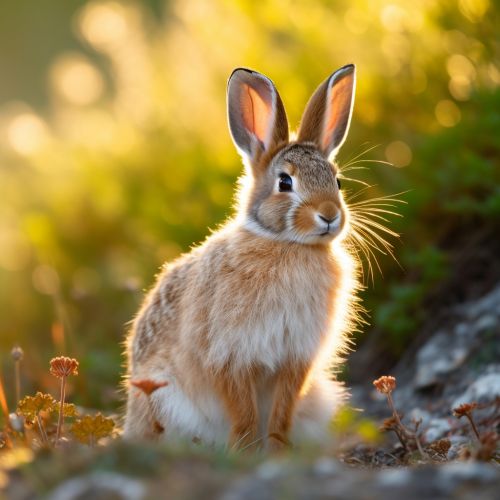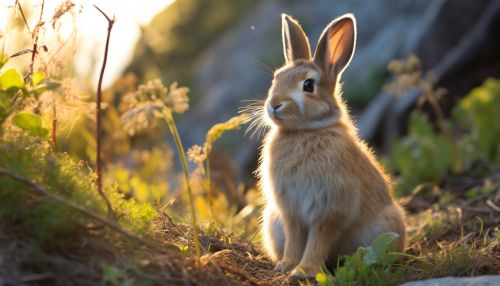Rabbit
Classification and Evolution
Rabbits are small mammals in the family Leporidae of the order Lagomorpha, which also includes hares and pikas. This family is characterized by their long ears, large hind legs, and short, fluffy tails. The scientific name for the rabbit is Oryctolagus cuniculus.


Rabbits evolved from rodents in the early Eocene period, around 40 million years ago. The earliest known ancestor of the rabbit is the Amphilagus, a small mammal that lived in Europe during the Miocene epoch. Over time, rabbits have evolved to adapt to a variety of environments, from deserts to forests to grasslands.
Anatomy and Physiology
Rabbits have a compact and lightweight body, which allows them to move quickly and efficiently. Their long ears, which can be more than 10 cm (4 in) long, are probably an adaptation for detecting predators. They have large, powerful hind legs, which are used for both hopping and digging. Their short, fluffy tails, which are white underneath, are used for signaling danger.
Rabbits have a unique digestive system, which allows them to extract nutrients from plants that other animals cannot digest. They are hindgut fermenters, and eat their own feces to obtain the maximum nutritional value from their food. This process, known as coprophagy, is essential for their survival.
Behavior and Ecology
Rabbits are primarily crepuscular, being most active in the early morning and late evening. They are also somewhat nocturnal, although they are not as active at night as some other nocturnal animals. They spend most of their time in complex burrow systems, known as warrens, to escape predators and extreme weather.
Rabbits are social animals, and live in large groups called colonies. They communicate with each other through a variety of vocalizations, as well as through scent marking and body language. They have a complex social structure, with a dominant male, known as the buck, and a dominant female, known as the doe.
Reproduction and Lifespan
Rabbits are known for their high reproductive rate. The gestation period for a rabbit is around 30 days, and the doe can give birth to a litter of up to 14 young, known as kits. The kits are born blind and hairless, but grow rapidly and are weaned at around 4 weeks of age.
The average lifespan of a rabbit in the wild is around 2 to 3 years, although some individuals have been known to live up to 8 years. In captivity, rabbits can live up to 10 years or more, with the oldest recorded rabbit living to be 18 years old.
Human Interaction and Domestication
Rabbits have a long history of interaction with humans. They have been hunted for their meat and fur for thousands of years, and were first domesticated by the Romans in the first century BC. Today, rabbits are kept as pets, raised for meat and fur, and used in scientific research.
Domestic rabbits are significantly different from their wild counterparts, having been selectively bred for a variety of traits, including size, color, and temperament. There are more than 300 recognized breeds of domestic rabbit, ranging from the tiny Netherland Dwarf to the large Flemish Giant.
Conservation and Threats
Despite their high reproductive rate, many species of wild rabbit are threatened with extinction due to habitat loss, disease, and overhunting. The most famous example is the European rabbit, which has been decimated by the disease myxomatosis and the viral hemorrhagic disease RHDV.
Conservation efforts for rabbits typically involve habitat preservation and restoration, as well as captive breeding and reintroduction programs. However, these efforts are often hampered by the rabbits' high reproductive rate, which can lead to overpopulation and ecological imbalance.
